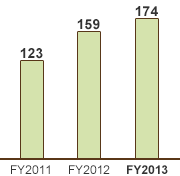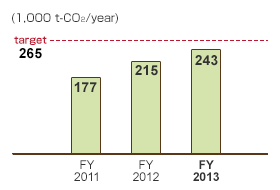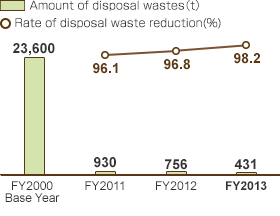- Home
- Sustainability
- Social and Environmental Report (Download)
- Environmental Report - Social Responsibility 2014
Environmental ReportSocial Responsibility 2014
Recognizing that our business activities affect the entire planet and that protecting the global environment is essential for our survival and activity, we work voluntarily and proactively to protect the environment under the Nisshin Seifun Group's Basic Environmental Policy, including initiatives to reduce waste and CO2 emissions and to effectively use resources and energy.
Material Balance
We have identified the major environmental impacts of our operations as electricity and water consumption, CO2 and waste emissions. We strive to promote effective environmental management and reduce environmental impacts through such means as understanding our footprint from production and distribution to consumer use and eventual disposal of residual packaging.




*Based on Act concerning the Promotion of Utilization of Recyclable Food Waste
Environmental Management
Under the leadership of the Director for Environmental Issues, we implement our Group Environmental Policy to conduct business in an environmental responsible manner. We evaluate each business site, including offices and plants for compliance with laws and regulations through internal audit according to our stringent standards. We also ensure our continuous improvement through group-wide certificated Environmental Management System under ISO14001.
| Number of operating companies |
Number of sites |
Results | ||
|---|---|---|---|---|
| Improvement orders |
Improvement recommendations |
|||
| FY2011 | 13 | 30 | 1 | 3 |
| FY2012 | 10 | 30 | 1 | 1 |
| FY2013 | 12 | 23 | 1 | 1 |
Climate Protection

We have been thoroughly reviewing the Group-wide use of electricity by introducing energy-efficient facilities at our plants and energy-saving air-conditioners, lighting apparatuses and OA equipment at our offices.
Although we accomplished our group’s original target, from the effect of increase in production and by the addition of CO2 emissions of newly acquired overseas companies, a total CO2 emission in 2013 was increased.
We have been thoroughly reviewing the Group-wide use of electricity by introducing energy-efficient facilities at our plants and energy-saving air-conditioners, lighting apparatuses and OA equipment at our offices.
Also, we used green electricity to cover a part of domestic power usage
Introduction of Renewable Energy Facilities

The Tsurumi Plant of Nisshin Seifun and the Tatebayashi Plant of Nisshin Foods installed solar photovoltaic facilities. The facility at the Tsurumi Plant is expected to generate power equivalent to annual consumption of 160 households, and to relieve the environmental impact by reducing approximately 250 tons of CO2 emissions annually compared with thermal power plant.
Waste Reduction

*Excludes overseas sites
We actively worked on reducing waste on a group-wide basis by improving production efficiency and reviewing procedures at the manufacturing division, as well as strengthening supply and demand and inventory management at the sales division. Additionally we made efforts to promote the use of waste for fertilizers and foodstuffs. As a result, final disposal waste in FY2012 reduced nearly 98.2% from that in FY2000.
Consideration to Biodiversity

Natural blessings are essential for the businesses and products of Nisshin Seifun Group.
Thus, we provide input and opportunities for employee to understand the linkage of biodiversity with our business and everyday life. Moreover, through support for the authorized NPO to protect Kiritappu Wetland and nature research activities, we are striving to help national blessings underpin the creation of the people's healthy and fruitful lives.
Support for Kiritappu Wetland National Trust

The Kiritappu Wetland is a wetland area in Hamanaka-cho, Akkesi District, Hokkaido, Japan. This wetland is the third largest wetland in Japan. The wetland is home to various flora and fauna. The Kiritappu Wetland is registered under the Ramsar Convention as an important habitat for the waterfowl. In a bid to preserve this wonderful wetland, Nisshin Seifun Group Inc. is assisting the Kiritappu Wetland National Trust, an authorized NPO, which buys private land and develops wetland conservation activities.







